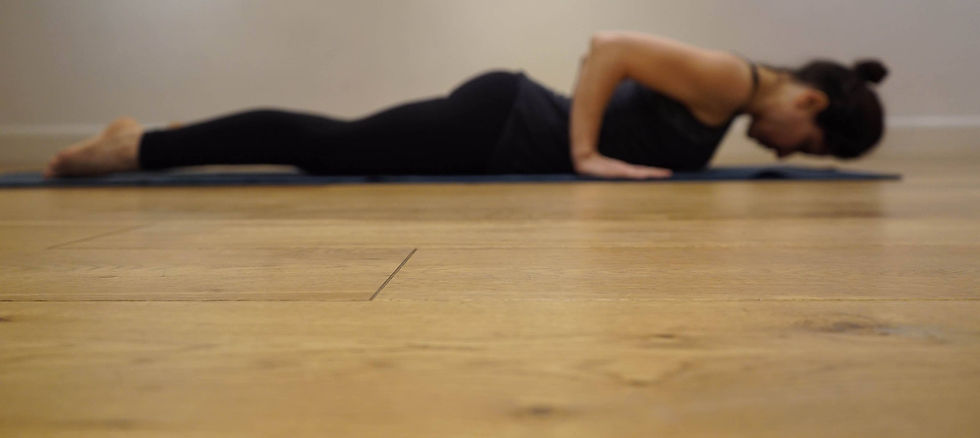The pursuit of the 'minimal' in minimum yoga
- Emanuela

- Nov 19, 2020
- 5 min read
Updated: Dec 28, 2024
I would have written a shorter letter but I did not have the time.
Blaise Pascal

As yoga practitioners we have different motivations that keep us going back to the mat: some seek to improve physical performance, while others need relaxation, or enjoy the dedication to a practice. Many find value in establishing a healthy routine for mental and physical wellbeing, and others find that yoga is an essential part of their lives. We use a combination of movement, meditation and breathing techniques which help to bring integration in our mindbody system. It is in this sense that this is a holistic practice: a practice of the whole. Through movement and meditation we attempt to uncover the many layers of physical and mental ‘conditioning’ to find again the wholeness that was always already in us.
I have always personally lived the journey of yoga as a process of elimination, cleansing, and ultimately liberation. From the moment we are born, our lives are spent collating layer upon layer of information, instruction, learning. This happens in the often unconscious effort to “become” something or someone, as if we weren’t always already whole. Practical conditioning is important and essential to our existence: we learn to use tools, to express ideas, we acquire technical skills, etc. This is how our wonderful brains work best: by establishing new neural pathways through the ever-evolving process of learning. However, beyond this functional and useful conditioning, we also tend to accumulate a lot of unnecessary (and often damaging) information, often as a byproduct of that learning, for example in the form of expectations or assumptions about who we should be, what our bodies should be able to do, or look like, what causes we should be supporting, etc. Soon we find ourselves trapped into a network of false beliefs that we fall into automatically, and that ultimately exhaust us. Yoga helps clearing some of that cluttering by taking us back to a sense of simplicity, matter-of-factness, connection to ourselves and the space around us, presence. This process for me has always been at the same time both physical and mental.
In mathematical problem solving, the proof of a theorem is said to have mathematical elegance if it is simple and insightful. It might involve a minimal amount of computations, while proving a highly generalisable outcome. I have always liked this simple and powerful idea. Transferring it to the yoga practice, one could say that performing lots of different postures during one single session of yoga, without the necessary focus/application/awareness can't be the ‘solution’ that we’re looking for, and it won’t even make the practice ‘more dynamic’ simply because of the number of postures 'done' (as if they're ever done). It could in fact be more a pretext to stay busy, which is more likely to overwhelm our nervous system with an overload of movement stimuli. This is particularly true if we are practising in a mixed-level class, where people have different needs/backgrounds: some have injuries, others have never practised before, others have many years of practice behind them.
It seems to me that slowing down, refining the relationship between each movement and the breath, working on repeating some postures (as I learned in Maty Ezraty), or exploring the same posture in different ways, might be more beneficial at times. This helps us connect to the poses at a deeper level, specific to each individual’s circumstances. It is more ‘elegant’ (in the mathematical sense) approach than, say, trying to do a lot in a short time, replicating the overload-drive that we’re exposed to in everyday life.
This is partly the reason why the Ashtanga Vinyasa system remains my primary asana practice. In providing a sequence of ‘trialled and tested’ poses, it works as a script, or a score that, once memorised, can be followed and refined to the beat, but can also be tinkered and experimented with. Not to mention its cyclical nature, the ‘eternal recurrence’ of daily practice, or even of certain transitions within one single practice session (chaturanga-upward dog-downward dog), which develop strength and stamina, but also focus and equanimity.
When I created Minimum Yoga in 2014 I wanted to bring this important aspect of the yoga practice to the fore. The ‘minimum yoga’ practice I aspire to as a practitioner and that I encourage in my students is not so much the ‘less is more’ approach, however supportive of that approach I might be. It’s not even about minimising the ‘quantity’ of practice in favour of its consistency (five minutes a day being better than two hours every two weeks), however useful and effective this might be. It’s more about finding a ‘quality’ in the practice where the unnecessary is removed, to let the essential emerge in the quality of presence, awareness, play, focus, humour. Being here and now. You can have a minimal practice of three hours. It takes time to work minimally, as it does to write Pascal’s short letter.
What’s the minimum amount of yoga practice needed?
I’ve often been asked this question. The immediate answer is: the minimum amount is as much as you need, daily or weekly, to feel awake, or cleansed, or renewed, or relaxed, or simply to feel better than you felt before practice. This feeling of transformation (from a state of torpor or tiredness, to one of presence and awareness) is necessary for you to feel motivated to return to the mat next time.
However, when I created Minimum Yoga I was not thinking about a ‘minimum amount’. Minimum Yoga is an invitation to approach your practice from the point of view of quality rather than quantity. It is an invitation to set aside some time every day, or several days a week, or once a week, to press ‘pause’ on daily tasks, and sit or lie still for a while, allowing the healing process of movement to emerge, presence to emerge from emptiness, body awareness to surface and break through slumber. It’s not about how much yoga should I do, but how should I do this yoga? Inspired by minimalism and the art of attention, it’s about mindful exploration without assumptions/expectations.
Whether you are practising Ashtanga, some other dynamic sequence, or Meditation, a minimum yoga practice is about being with each moment, without cramming the mind with what is coming next, or with concerns such as ‘how did I do the last posture?’. It’s about connecting to the signals the body sends as you breathe in and out of each posture, as you breathe while in the posture, and so on. It’s also about focusing the mind on a single point, letting external events be in the background, drawing the attention inwards, pacifying the mindbody, reducing stimulation, creating less (rather than more) activity in the mind. Chitta vritti nirodha.
Therefore, with Minimum Yoga I encourage students to find not a very short practice (although that remains a better option than no practice), but a minimal practice: one in which we refine our mindbody awareness through perhaps longer holds, or through repetitions of the same posture to explore its many layers, or we go through aspects of the Ashtanga practice, carefully entering and exiting each posture through the minimal rhythm of the vinyasa count and the one-pointed focus of drishti, taking care to leave out any unnecessary movements, embellishments, fidgeting, visual distractions, etc. But I will write more about my approach to the Ashtanga practice another time.

Join me for a 'spring-cleaning' practice online on Sunday 27 March, 11am-1pm (UK time). https://www.minimumyoga.com/service-page/welcome-to-spring-yoga-for-renewal



Yorumlar